

The island is in news these days as US policy toward Havana thaws. A Beijing restaurant showcases five dishes that will make you an expert on this tropical cuisine, Mike Peters reports.
Even in winter, the atmosphere at Caribeno is warm, thanks to brilliantly colored murals with palm trees and the eager faces of staff members with ethnic roots in the Caribbean, Spain and Africa.
The atmosphere is electric, with a small stage for live music (salsa lessons and dance shows are held on Friday nights). Photos on the wall include ambassadors and entrepreneurs from many Latin countries, as well as scenes of Havana life, Caribbean beaches and icons like Che Guevara, who looks across the restaurant from an enlarged print of a Cuban 3-peso bill. (Guevara was once head of the central bank.)
The lively bar features creative cocktails made with rum, one of Cuba's most famous exports. One of the most popular is a sunset-colored treat called "The Hemingway" after the famous American writer who lived in Havana during the 1950s.
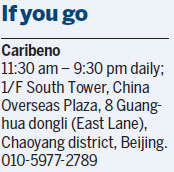
The melting pot of cultures in Cuba is vividly reflected in the food. Ropa vieja, a tomato-based stew of shredded beef, is often called Cuba's national dish, has its origins in the Sephari Jewish community of Spain in the 12th century; it evolved in the Canary Islands and finally in Cuba. Seafood salads made lively with mango or avocado. A bright green dipping sauce of parsley is so silky smooth that it makes everything delicious, from roast pork to deep-fried yuca, a fiberous local yam.
Yuca and a combination of black beans and rice are the most common side dishes, but you can also choose a Cuban tamale, steamed in a plantain leaf.
Executive chef Osmani Castillo has been in China for a while, running kitchens in Tianjin and Beijing (including the now-closed but much-mourned Casa Latina at the Solana mall). "I came to China for love," the big man says with a hearty laugh. Castillo was cooking in a Havana hotel when he met a Chinese businesswoman who was staying there. They've been a couple ever since, and Castillo has enjoyed being a tour guide as they visited old Havana, beautiful beaches nearby and scenic spots such as Pinar del Rio and Artemisa.
Finding some of his ingredients in China has taken some ingenuity. "We use the yerba bueno in our mojitos," he says of the fragrant herb often called Cuban mint. "It was nowhere to be found in the markets, but I was lucky - someone started a patch growing in the garden at the Cuban embassy." Luckily, the plant grows quickly.
Besides his nation's iconic rum, fine Cuban cigars are on hand for restaurant patrons as well.
China Daily's team of food writers recently visited Caribeno to explore the basics of Cuban cuisine. Here are five dishes that show the range of the vibrant food culture.
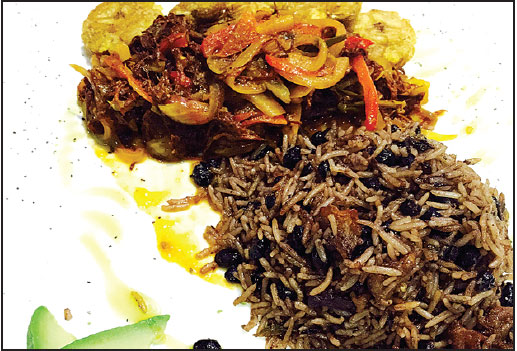
Ropa vieja
What it is: Literally meaning "old clothes", this is considered the national dish of Cuba, with variations in the Canary Islands, Venezuela and elsewhere. Cuba's version is shredded flank steak in a tomato sauce, served with fried plantains (a type of banana), Cuban-style black beans and rice, and slices of avocado.
Price: 68 yuan
Comments: Very savory thanks to onions and green bell peppers cooked with the beef. The generous helping of black beans and rice make this a very filling plate.
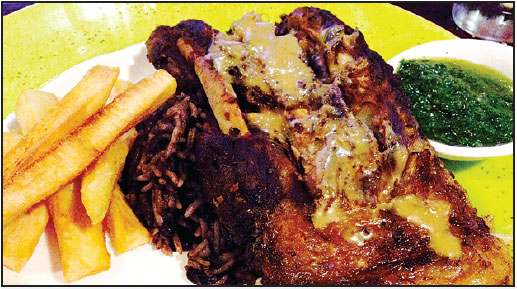
Pork chop with fried yuca
What it is: A savory chop grilled with Cuban spices. Cuban chefs, like their Chinese counterparts, use plenty of pork.
Price: 58 yuan
Comments: Very juicy, not at all dry. Black beans and rice maybe substituted for the yuca.
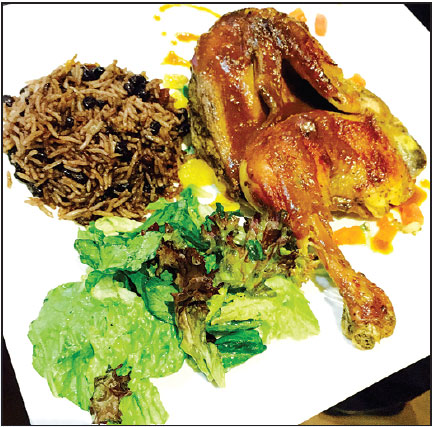
Chicken aljibe
What it is: Garlic and orange are the foundation of the sauce for this classic roast chicken. Considered a Cuban culinary gem, there are restaurants in Havana devoted to this dish.
Price: 65 yuan
Comments: Tender and very flavorful, with a nice helping of Cuban rice and beans and a small salad on the side.
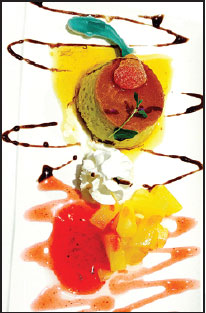
Grandma's flan
What it is: A traditional creamy vanilla custard with caramel sauce.
Price: 26 yuan
Comments: We suspect chef Osmani Castillo has embellished his granny's presentation, but the taste, he says, is all hers. This classic Latin dessert maybe on the sweet side for Chinese diners, who might prefer Castillo's arroz conleche (rice pudding), which sings thanks to an infusion of cinnamon.
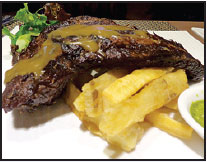
Pork ribs
What it is: The seoven-roasted ribs have a lot of mojo, which is a mix of lime, bitter orange, salt and garlic used to marinate the meat to make it fork-tender.
Price: 60 yuan
Comments: The rich sauce goes well with the fried yuca, the starchy tuber vegetable, served on the side.
Contact the writer at michaelpeters@chinadaily.com.cn
|
Brilliantly colored murals reflect Cuban folklife as the staff serves up specialties like chicken aljibe at Caribeno. Photos By Mike Peters And Dong Fangyu / China Daily |
(China Daily 01/08/2015 page24)